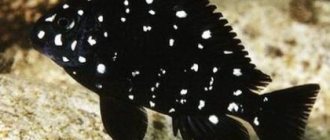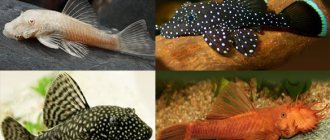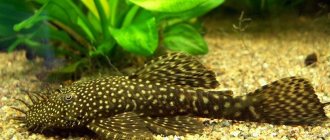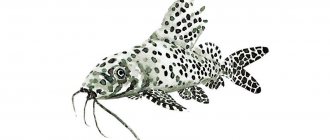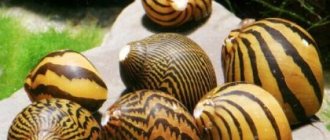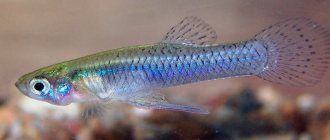The star ancistrus L181 (lat. Ancistrus hoplogenys) is a good aquarium cleaner and master of camouflage. Sometimes he doesn't move for hours, so it seems like he's no longer alive. They blend in so much with the environment that it is sometimes difficult to see them, even knowing where it is. They look very unusual with their spiky muzzle, but at the same time this is what makes them so attractive.
Description
In nature, star catfish inhabit rivers, swamps and lakes of the Amazon, Brazil and Peru. They love reservoirs with rocky and clay bottoms. Juveniles are found in shallow waters, while adults are found in shaded areas.
Appearance
The maximum size of the oblong body is up to 9 cm. There are protective plates on the back. The color of the body and fins is black with small white dots. As the dots grow, they fade to brown. On the head there are dark eyes and a mouth with a suction cup and scraper. There are numerous branches. The fins of young star catfish are edged with white, which fades with age.
Character
Star ancistrus are peaceful and shy catfish that prefer a nocturnal lifestyle. During the day, unsociable fish hide in shelters and can freeze in one place for hours. They camouflage well. Skirmishes happen within a species. Newly acquired individuals are shy, but, having gotten used to it, they often come out of hiding and eat during daylight hours.
Lifespan
Ancistrus catfish lives on average 10 years.
Appearance Features
As a member of the Chainfish family (Loricariidae), Ancistrus stellata has a peculiar armor of bony plates on its body, which covers the back, but is absent on the ventral side. Like other catfish of this family, its body is slightly flattened and elongated in length. The suction cup-shaped mouth is equipped with scrapers that help catfish of this family scrape algal fouling from underwater objects.
Individual appearance features that distinguish the stellate from other types of ancistrus:
- Small white-bluish “stars” are scattered on the body and on the fins, which are black in color, which darken with age and acquire a brown tint.
- The dorsal and caudal fins of young fish are “decorated” in the form of a wide white stripe, which disappears in adult fish.
This color, clearly visible in the photo of Ancistrus stellata, is especially bright in young individuals, also attracts the attention of aquarists to this fish. Very similar appearance features are observed in the “star catfish”, which has a completely different Latin name (Ancistrus leucostictus) and is distributed only in the northern territories of South America. Sometimes these two species are “mixed” into one, and if it is important to you what type of catfish you buy in the store, ask for its Latin name.
Content
Star catfish are unpretentious and survive in wide ranges of temperature and water hardness. You can recommend the fish to responsible beginners who will monitor the cleanliness of the soil and water.
Aquarium
A 50-liter aquarium is enough for one star ancistrus. For two individuals, 200 liters is better to prevent clashes. It is optimal to keep a male and 2 females. Place driftwood, which will serve as a source of beneficial supplements. Wood plays an important role in the digestion of fish. Ancistrus gnaws nutrients from the surface of driftwood. Neglecting this advice will lead to fish illnesses. Other shelters are also needed, among which the star catfish will hide:
- grottoes;
- caves;
- piles of stones.
View this post on Instagram
L404 tank again with plenty of l404 and L181 juvies leaving caves all the time. #l404 #l181 #hypancistrus #ancistrus #starlightpleco #pleco #countrysideaquatics #plecobreederandseller #pleco #staffspleco #plecobreeding #rareaquatics #staffsfishsales #stokepleco #staffspleco #midlandsplecocenter
A post shared by Carl Dutton (@countryside_aquatics) on Oct 1, 2018 at 8:54am PDT
Water parameters
| temperature | 20–28 degrees |
| rigidity | 1–20 dGh |
| acidity | 6–7.5 pH |
Change a quarter of the water volume to fresh water weekly and clean the soil with a siphon.
Plants
You don't need a lot of plants, but a few plant covers are advisable. The relationship of star catfish to plants varies. Ancistrus sometimes damage tender plants, especially Echinodorus and Schisandra, even if the diet includes a sufficient amount of herbal supplements. In some cases, fish are kept in herbal gardens, where the plants remain unharmed. Secure the roots by pressing them with a stone or attaching the plant to a piece of driftwood, then the catfish will not dig them up. Suitable for keeping with Ancistrus:
- Anubias;
- Vallisneria;
- Java moss;
- Cladophora;
- duckweed.
Priming
Place pebbles or gravel on the bottom. You can mix pebbles with sand. Make sure the stones do not have sharp corners. Boil the soil before placing it in the aquarium.
Equipment
For a full life of fish you will need:
- filter;
- compressor;
- heater.
Provide ancistrus with high-quality aeration and filtration. Heating the aquarium is necessary when the room temperature is low.
Lighting
If there are light-loving plants in the aquarium, make sure that they have enough light. Ancistrus is comfortable in dim, diffused light.
Feeding
Feed star catfish in the evening or at night with sinking plant food:
- cucumbers;
- zucchini;
- granules with spirulina;
- spinach;
- peas;
- carrots.
Sometimes feed the ancistrus live food in an amount of no more than 20% of the total diet. The catfish eats the leftover food of other fish. Monitor the feeding process: the food must sink; you can tie a weight to it.
View this post on Instagram
#l181 #catfish #fish #aquarium #fishtank #aquarium #fish #aquariumfish #catfish #ancistrus #starryancistrus
A post shared by @ kseniyamd_aquaworld on Apr 19, 2021 at 1:08pm PDT
Power and Compatibility
Star ancistrus are typical herbivorous fish. In nature, they eat bottom fouling and algae. In aquarium conditions, naturally occurring fouling of certain algae is a good food for them. This food must be supplemented with other plant foods (vegetables and herbaceous plants). Live food should also be given, but no more than a fifth of the daily ration.
Star ancistrus get along well and peacefully with any other species of aquarium fish. But in relationships with same-sex individuals of their species, they are very aggressive due to their territoriality. Males often get into real fights.
Reproduction
Ancistrus starfish are caring parents; they do not eat laid eggs and fry. Spawning occurs in a general or separate aquarium. Stimulate spawning with frequent water changes and a gradual decrease in temperature to 20 degrees. Equip the aquarium with ceramic tubes with a diameter of 4–5 cm, in which the fish will place their eggs.
How to distinguish gender
It is easy to determine the sex of star catfish:
- males are more elongated and larger than females;
- the abdomen of females is fuller;
- a mustache grows on the front of the male's head (at 2 years of age);
- males have a pointed muzzle;
- The female has fewer processes on the head, they are located closer to the edge of the lip.
Pregnancy
Sexual maturity in starfish occurs at 8–12 months; the male chooses a place for spawning and clears it of pollution and algae. When the shelter is ready, the male invites the female. The female lays 50–200 pinkish-orange eggs. After spawning, the female can be removed. The male takes care of the clutches, fanning them with his fins and removing infertile eggs. Often the male stops feeding during the period of nursing the offspring. Incubation time is up to 10 days. After the offspring hatch, remove the male, since from that moment he ceases to care for the offspring.
How to care for fry
Keep your water parameters stable and change the water a couple of times a week. At 1.5 months, the fry can be moved to adults. Feed small catfish on the 3rd–4th day of life with Artemia nauplii or Cyclops. Later, feed the crushed food to the adult catfish. Diversify your diet with live food. Wash and treat food with methylene blue or freeze it before serving. Place a small driftwood or coconut shells boiled for an hour so that the growing fish gnaw them.
Diseases
Star catfish have strong immunity. When water is contaminated, aquarium inhabitants are susceptible to:
- Ichthyophthyriasis. The disease is known as “semolina.” White growths appear on the body, the pet loses appetite and does not leave the shelter. Treat the disease with drugs from a pet store based on copper sulfate or malachite green. Read the instructions carefully, because an excess of the drug is dangerous for aquarium inhabitants.
- Oxygen starvation. Hypoxia occurs more often at high temperatures. Cool the water and increase aeration. Another reason for lack of oxygen is overcrowding of the aquarium.
- Poisoning. Excess nitrites and ammonia provoke poisoning in ancistrus. For prevention, test the water with tests for the content of nitrogen compounds. Replace up to 40% of the water. Add conditioners that neutralize hazardous substances and increase aeration.
- Oodiniumosis. Another name is “velvet rust”. If you notice that the fish is itching against the decorations, trembling, or the skin is covered with a yellowish coating, increase the water temperature and pour copper sulfate into the aquarium, according to the instructions. Do not turn off the aeration during treatment.
History of breeding and areas of distribution of catfish - Ancistrus starfish
This is one of the most beautiful representatives of the Ancistrus genus. It got its name due to its beautiful bright coloring, when many luminous white dots are scattered across a dark background. These fish also attract attention due to their impressive size. But in general, these are very unpretentious fish that even a novice aquarist can keep.
The Ancistrus starfish species is found in the wild in Brazil, Peru and Guyana. These fish live in rivers with strong currents.
Reviews
The star-shaped inhabitants of the aquarium delight aquarists. Breeders value fish for their slowness and unique appearance. Star Ancistrus has helped many in the fight against algae.
Living together with other fish
Catfish alone in the aquarium may not be enough and the aquarist is faced with a situation that requires choosing friendly neighbors for the ancistrus. Typically, star ancistrus are characterized by a peaceful disposition. But, according to reviews from aquarists, you can find out that these catfish sometimes spoil the lives of their clumsy neighbors (goldfish, large cichlids and sacbranch catfish).
Ancistrus can suffer from proximity to piranhas and other predatory fish. Conflicts over shelters arise with other bottom-dwelling fish, such as corydoras. It is recommended to choose the following as safe neighbors:
- guppy;
- any representatives of characins;
- barbs;
- swordtails.
Any active fish that live in the middle layers of water will be good neighbors for bottom-dwelling catfish.


